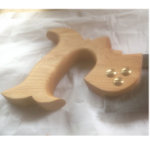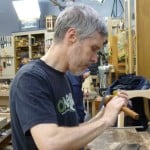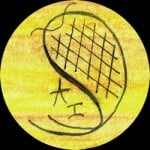My very first project: a Hand Mirror!
Welcome! / Forums / General Woodworking Discussions / Projects / My very first project: a Hand Mirror!
- This topic has 10 replies, 10 voices, and was last updated 10 years, 2 months ago by
 Jay.
Jay.
-
AuthorPosts
-

Hi all,
I recently completed my very first woodworking project: a hand mirror. Also called a vanity mirror I think? Anyways, this was my first time shaping wood.
I saw some nice ones on the web and I realized that several techniques taught by Paul could also be applied in making one. Plus I think they make nice gifts 🙂
But I think mainly I wanted to try an idea I had for cutting the mirror recess. It occurred to me that the recess could be made via a “circular” knife wall. I wasn’t entirely sure it would work, but it did! I included one photo to show how I went about it. I used a cheapie plastic circle cutter from an art store to score the circle, then I used a 1/2″ chisel to pop up the wood at the knife wall, like Paul teaches for housing dadoes and such. I left an island of wood in the middle which I removed with angled chisel chops and a router plane. Working slowly, the result was much better than I had imagined.
I cut one side of the outside shape with a coping saw, and I tried the other side using the stop cut technique. The stop cut way is a little trickier than I thought. I have to practice that more. I finished up with an ancient unnumbered Stanley spokeshave I found at an antique shop for 5 USD, a Nicholson USA-made #49 rasp, and assorted files and sandpaper. I got lucky and found that Made-in-USA #49 in a local hardware store; my understanding is that the Brazil-made rasps being sold now are not that good. It’s a good rasp but I could use something finer.
The wood is 3/4″ thick birch from the Home Depot. I chose birch because it was cheap 🙂 and I found a board with some nice silky looking areas that glisten at the right angle. It’s pretty heavy and dense, and it carves well. The finish is French Polish in super blonde shellac I mixed myself. I have some experience in French Polishing from a guitar that I refinished. For that hand-rubbed look and feel, I ended with 0000 steel wool, Trewax, and a whole lotta elbow grease! It feels nice to the touch which is important in something like a hand mirror I think.
The design is pretty simple and modest. I wanted to keep my first one simple. For this one, my main goal was to have gentle sweeping curves that felt nice to hold. But I already have ideas for my next one 🙂
Any and all comments are very welcome!
Attachments:
You must be logged in to view attached files. 2 February 2014 at 8:51 am #27034
2 February 2014 at 8:51 am #27034Great idea Juan) Very nice project, good proportion)Thanks for sharing with us))


 2 February 2014 at 12:14 pm #27040
2 February 2014 at 12:14 pm #27040Very nicely done Juan and the finish looks great.
Birch is quite a pleasant wood to work with.

 2 February 2014 at 5:32 pm #27069
2 February 2014 at 5:32 pm #27069Looks like you did a really nice job fitting the mirror. That really does not look like a “first” project to me. Good job! Congratulations!

Thanks so much everyone for the kind words. I’m happy that you like it.
@davidr : Well, the circle cutter I used was just like this one:BUT! I should say that I do NOT recommend it and I won’t be using it again. It was barely adequate and it actually made for more work in the end. The biggest issue with this cutter was the blade’s double sided bevel. It works fine for a very shallow cut (say about 1/32-inch or maybe a hair deeper), but soon after that the outside bevel inevitably pushes the cutter inward, creating a recess that becomes slightly smaller and smaller in diameter as you go deeper. This was more difficult to neatly correct than I anticipated. Also, the needle point for securing the center of the compass is inadequate. What’s really needed there is a peg in a hole in the wood.
In my mirror, the recess is 5-inches in diameter and a bit over 3/16” deep. That’s kind of deep, but I wanted the bevel of the mirror to sit below the wood surface and I got it pretty close to that.
I’ve actually been working on making a heavier duty compass cutter, something quite rigid with a spear-type blade that can cut in both directions (for cutting with the grain). I just completed my prototype yesterday and it shows promise! I got down to a ¼-inch depth in only 3 steps (the cheap plastic cutter took more like 6 or 7 I think). But it’s in such a rough state that I’m embarrassed to show it lol! Once I make one that’s halfway presentable I’ll post it in the Tools forum.
@dave : I could talk about French polishing if you’d like, but I’ve come to realize that it’s something you learn mainly by doing. In other words, by practicing on a flat board. A lot. 🙂 If there is French polish thread on the forum I could talk about it there. I’m no expert, but I’ve come a long ways with it. But I do want to say that it’s not all that hard, and there’s no magic to it. There are only a few ingredients to the recipe, and the discovery lies in learning how each one affects the process. A guitar maker I know says he doesn’t try to explain French polishing because it is a very personal thing. That’s a bit romantic perhaps, but it’s sort of valid.There’s only one source of information I can somewhat recommend, the Millburn tutorial. Their website is down, but someone made a Word file out of that information, here:
Just don’t forget that there is a large surplus of information there. You sure don’t need to do everything that’s there. But it’s worth a read. Just remember to forget most of it once you’re done. 🙂
-
AuthorPosts
- You must be logged in to reply to this topic.
